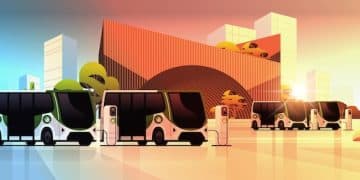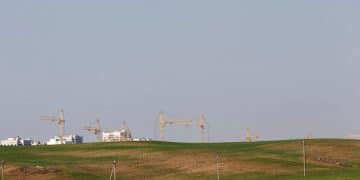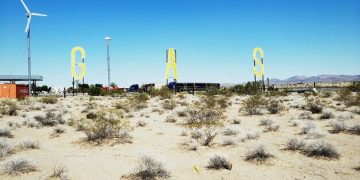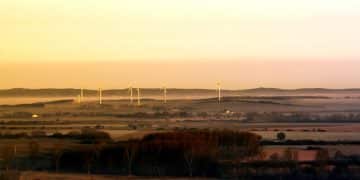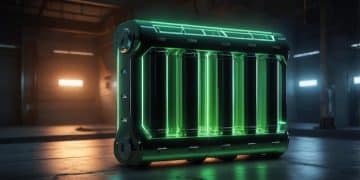Environmental Impacts of Wind Energy in the US: A Comprehensive Analysis
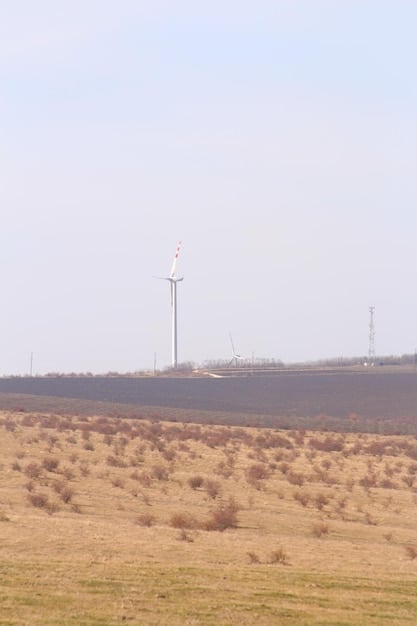
Large-scale wind energy development in the US presents potential environmental impacts, including effects on wildlife, habitat disruption, noise pollution, and visual alterations of landscapes, requiring careful assessment and mitigation strategies.
Wind energy is a rapidly growing sector in the United States, offering a promising alternative to fossil fuels. However, understanding what are the potential environmental impacts of large-scale wind energy development in the US is crucial to ensuring a sustainable energy transition.
Understanding the Scope of Wind Energy Development in the US
Wind energy has emerged as a significant player in the US energy landscape, driven by the need to reduce carbon emissions and enhance energy security. The expansion of wind farms across the country has raised important questions about their environmental footprint.
This section provides an overview of the scale and distribution of wind energy projects in the US, highlighting the key factors influencing its growth and the regions most affected by its development.
Current Wind Energy Capacity and Distribution
The US has witnessed a substantial increase in wind energy capacity over the last two decades, becoming one of the leading countries in wind power generation. Texas, Iowa, Oklahoma, Kansas, and California are among the states with the highest installed wind capacity.
These states benefit from favorable wind resources and supportive policies that have encouraged investment in wind energy infrastructure. The distribution of wind farms is largely concentrated in the Great Plains and along coastal regions, where wind speeds are consistently high.
Factors Driving Wind Energy Growth
Several factors have contributed to the proliferation of wind energy in the US. Government incentives, such as tax credits and renewable energy mandates, have made wind power more economically competitive. Technological advancements in turbine design and efficiency have also played a key role.
Additionally, increasing public awareness of climate change and the need for cleaner energy sources has fueled demand for wind energy. Corporate sustainability goals and commitments to renewable energy procurement have further driven the growth of the wind energy sector.

The scale of wind energy development continues to expand both onshore and offshore. Below is a summarized list:
- Economic Incentives: Tax credits and subsidies reduce the cost of wind energy projects.
- Renewable Energy Standards: State mandates require a certain percentage of electricity from renewable sources.
- Technological Advancements: Improved turbine efficiency increases energy production.
- Environmental Concerns: Growing awareness of climate change drives demand for clean energy.
The expansion of wind energy in the US presents both opportunities and challenges. While it offers a pathway to reduce greenhouse gas emissions and diversify the energy mix, it also raises concerns about its environmental impacts, which need to be carefully evaluated and addressed.
Wildlife Impacts: Birds and Bats
One of the most significant environmental concerns associated with wind energy is its potential impact on wildlife, particularly birds and bats. Wind turbines can pose a direct threat to these species through collision with turbine blades.
Understanding the mechanisms of these impacts and implementing effective mitigation strategies are essential to minimizing the ecological consequences of wind energy development.
Collision Risks and Mortality Rates
Birds and bats are vulnerable to collisions with wind turbine blades, which can result in injury or death. The risk of collision varies depending on the location of the wind farm, the species present in the area, and the design and operation of the turbines.
Mortality rates for birds and bats at wind farms have been a subject of ongoing research and debate. While some studies suggest relatively low mortality rates, others have raised concerns about the cumulative impact on certain species populations.
Factors Influencing Collision Risks
Several factors can influence the risk of bird and bat collisions at wind farms. Turbine height, blade length, and rotation speed can affect the likelihood of collisions. Landscape features, such as migration corridors and foraging areas, can also increase the risk.
Weather conditions, such as wind speed and visibility, can play a role in collision events. Some species are more prone to collisions than others due to their flight behavior, habitat preferences, and susceptibility to turbine-induced turbulence.
Mitigation Strategies and Best Practices
To mitigate the impact of wind turbines on birds and bats, various strategies and best practices have been developed and implemented. These include:
- Siting Considerations: Avoiding sensitive habitats and migration routes during wind farm development.
- Operational Measures: Curtailing turbine operation during periods of high risk, such as nocturnal migration.
- Technological Solutions: Implementing deterrent systems, such as acoustic or visual signals, to discourage birds and bats from approaching turbines.
- Monitoring and Adaptive Management: Continuously monitoring wildlife populations and adjusting mitigation measures as needed.
Effective mitigation requires a combination of careful planning, adaptive management, and ongoing research to better understand and address the risks posed by wind turbines to wildlife.
Habitat Disruption and Land Use
In addition to direct impacts on wildlife, wind energy development can lead to habitat disruption and alterations in land use patterns. The construction of wind farms requires land clearing for turbine foundations, access roads, and transmission lines.
These activities can fragment habitats, disrupt ecological processes, and affect the availability of resources for wildlife populations.
Direct Habitat Loss and Fragmentation
The physical footprint of wind energy facilities can result in the direct loss of habitat for plants and animals. Land clearing for turbine construction and infrastructure development can remove vegetation, disrupt soil structure, and alter hydrological regimes.
Habitat fragmentation, caused by the creation of roads and clearings, can isolate wildlife populations, reduce genetic diversity, and increase the risk of local extinctions. Sensitive ecosystems, such as grasslands, forests, and wetlands, are particularly vulnerable to the impacts of wind energy development.
Impacts on Ecosystem Services
Wind energy development can affect the provision of essential ecosystem services, such as carbon sequestration, water purification, and soil conservation. The removal of vegetation can reduce the capacity of ecosystems to absorb carbon dioxide, contributing to climate change.
Soil erosion and sedimentation, resulting from land clearing and construction activities, can degrade water quality and affect aquatic habitats. Disruption of natural hydrological processes can alter wetland functions and reduce the availability of water resources.
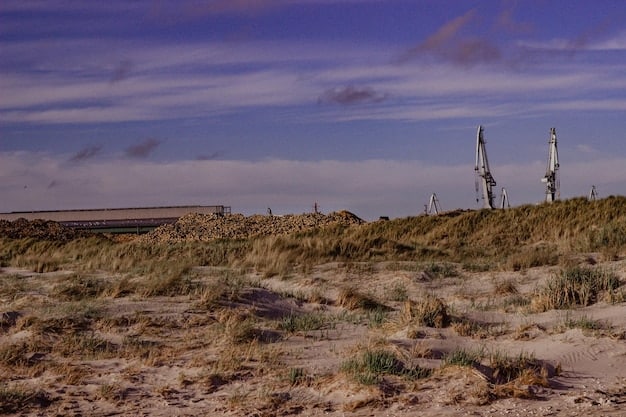
Land Use Conflicts and Aesthetic Impacts
Wind energy development can lead to land use conflicts with other activities, such as agriculture, forestry, and recreation. The presence of wind turbines can alter the visual landscape, affecting property values and recreational experiences.
Communities may have concerns about the noise generated by wind turbines, as well as the potential impact on scenic views. Careful planning and stakeholder engagement are essential to addressing land use conflicts and minimizing the aesthetic impacts of wind energy projects.
Below are some key factors to consider when planning a wind farm:
- Minimize Land Clearing: Reduce the footprint of wind energy facilities by optimizing turbine placement and infrastructure design.
- Restore Disturbed Areas: Implement restoration practices to revegetate cleared areas and stabilize soils.
- Avoid Sensitive Habitats: Avoid siting wind farms in ecologically sensitive areas, such as wetlands, forests, and grasslands.
- Engage Stakeholders: Involve local communities, landowners, and environmental groups in the planning and decision-making process.
Noise Pollution and Community Impacts
Noise pollution is another environmental impact associated with wind energy development. Wind turbines generate aerodynamic noise as their blades rotate, which can be a source of annoyance and concern for nearby residents.
Understanding the characteristics of turbine noise and implementing mitigation measures are important to minimizing community impacts.
Sources and Characteristics of Turbine Noise
Turbine noise is primarily generated by the interaction of wind with the turbine blades. The noise can be characterized as broadband, consisting of a range of frequencies, with a distinct “whooshing” sound as the blades pass by.
The amplitude and frequency of turbine noise can vary depending on factors such as turbine design, wind speed, and atmospheric conditions. Topography and vegetation can also influence the propagation of noise from wind farms.
Health and Well-being Effects
Exposure to turbine noise can have a range of effects on human health and well-being. While the scientific evidence is still evolving, some studies have suggested that turbine noise can lead to sleep disturbance, annoyance, and psychological distress.
Individual sensitivity to noise varies, with some people being more susceptible to its effects than others. The perceived loudness and annoyance of turbine noise can be influenced by factors such as distance from the wind farm, background noise levels, and visual impact.
Mitigation Measures and Noise Regulations
To mitigate the impact of turbine noise on communities, various measures can be implemented. These include:
- Siting Considerations: Maintaining adequate setback distances between wind turbines and residential areas.
- Turbine Technology: Using noise-reducing turbine designs and optimizing blade profiles.
- Operational Strategies: Curtailing turbine operation during periods of high noise sensitivity, such as nighttime.
- Noise Monitoring and Control: Implementing noise monitoring programs to ensure compliance with regulatory standards.
Effective noise management requires a combination of careful planning, technological solutions, and community engagement to minimize the potential impacts of turbine noise on nearby residents.
Visual Impacts and Landscape Aesthetics
Wind energy development can have a significant visual impact on landscapes, particularly in areas with scenic beauty or cultural significance. The presence of wind turbines can alter the character of the landscape, affecting its aesthetic value and recreational appeal.
Addressing visual impacts and preserving landscape aesthetics are important considerations in wind energy planning.
Perception of Visual Impacts
The perception of visual impacts from wind turbines is subjective and can vary depending on individual preferences, cultural values, and landscape context. Some people may find wind turbines to be aesthetically pleasing, viewing them as symbols of clean energy and technological progress.
Others may find them to be intrusive and disruptive, detracting from the natural beauty of the landscape. Factors such as turbine height, color, and spacing can influence the perceived visual impact.
Impacts on Tourism and Recreation
Wind energy development can have implications for tourism and recreation, particularly in areas that rely on scenic landscapes for their economic or cultural value. The presence of wind turbines can alter recreational experiences, such as hiking, camping, and wildlife viewing.
Some studies have suggested that wind farms can have a negative impact on tourism revenues, while others have found little or no effect. Careful planning and consideration of landscape values are essential to minimizing potential impacts on tourism and recreation.
Strategies for Minimizing Visual Impacts
To minimize the visual impacts of wind energy development, various strategies can be implemented. These include:
- Siting Considerations: Avoiding locations with high scenic value or cultural significance.
- Landscape Integration: Designing wind farms to blend in with the surrounding landscape.
- Visual Mitigation: Using landscaping, screening, or other visual barriers to reduce the visibility of turbines.
- Community Engagement: Involving local communities in the planning and decision-making process.
Effective visual impact management requires a combination of careful planning, aesthetic design, and community engagement to minimize potential impacts on landscape values.
Life Cycle Assessment and Overall Footprint
To comprehensively evaluate the environmental impacts of wind energy, it is essential to consider the entire life cycle of wind turbines, from manufacturing and installation to operation and decommissioning. Life cycle assessment (LCA) is a tool that can be used to quantify the environmental footprint of wind energy systems.
This involves assessing the energy and material inputs, emissions, and waste generated throughout the life cycle of wind turbines.
Energy and Material Inputs
The manufacturing of wind turbines requires significant amounts of energy and materials, including steel, aluminum, concrete, and composite materials. The extraction and processing of these materials can have environmental impacts, such as habitat disruption, air and water pollution, and greenhouse gas emissions.
The transportation of turbines and components to wind farm sites also requires energy and can contribute to air pollution. The construction of turbine foundations and access roads involves land clearing and soil disturbance.
Emissions and Waste Generation
The operation of wind turbines is generally considered to be emission-free, as it does not involve the combustion of fossil fuels. However, emissions can occur during the manufacturing, transportation, and installation phases. Waste is generated during the manufacturing process, as well as during turbine maintenance and decommissioning.
The disposal of turbine blades at the end of their useful life is a growing concern, as they are often made of composite materials that are difficult to recycle. Efforts are underway to develop recycling technologies for turbine blades and to reduce waste generation throughout the wind energy life cycle.
Comparative Analysis with Other Energy Sources
LCA can be used to compare the environmental footprint of wind energy with that of other energy sources, such as fossil fuels and nuclear power. Studies have generally found that wind energy has a lower greenhouse gas emissions intensity than fossil fuels, but a higher intensity than nuclear power.
The environmental impacts of wind energy can vary depending on factors such as turbine design, location, and operating practices. By considering the entire life cycle of wind energy systems, LCA can help to identify opportunities for reducing environmental impacts and improving sustainability.
| Key Point | Brief Description |
|---|---|
| 🦅 Wildlife Impacts | Collision risk for birds and bats, habitat disruption. |
| 🏞️ Habitat Disruption | Land clearing for turbines and infrastructure, affecting ecosystems. |
| 🔊 Noise Pollution | Aerodynamic noise from turbines, potentially affecting nearby residents. |
| 🌎 Visual Impacts | Alteration of landscape aesthetics, affecting tourism and property values. |
FAQ
▼
The main concerns include wildlife impacts (especially on birds and bats), habitat disruption from construction, noise pollution affecting nearby communities, and visual impacts on the landscape.
▼
Wind turbines can cause direct mortality through collisions with turbine blades. This risk is higher for certain species and in specific locations, especially during migration seasons.
▼
Mitigation strategies include careful site selection to avoid sensitive habitats, operational measures like curtailing turbine use during high-risk periods, and technological solutions that deter wildlife.
▼
Local communities might be affected by noise pollution from turbine operation and changes in landscape aesthetics. Effective community engagement and noise reduction technologies are crucial for minimizing these effects.
▼
While wind energy has environmental impacts, it’s considerably more sustainable than fossil fuels. It produces no emissions during operation, and efforts are being made to improve the sustainability of turbine manufacturing and disposal.
Conclusion
In conclusion, while wind energy offers a valuable pathway to a cleaner energy future in the US, understanding and mitigating what are the potential environmental impacts of large-scale wind energy development in the US remains critically important for ensuring a truly sustainable transition. Careful planning, technological innovation, and ongoing research are key to minimizing these impacts and maximizing the benefits of wind power.
